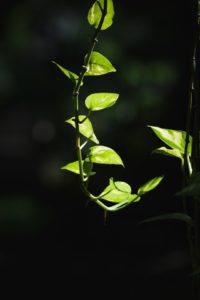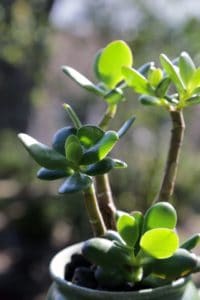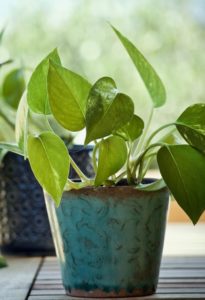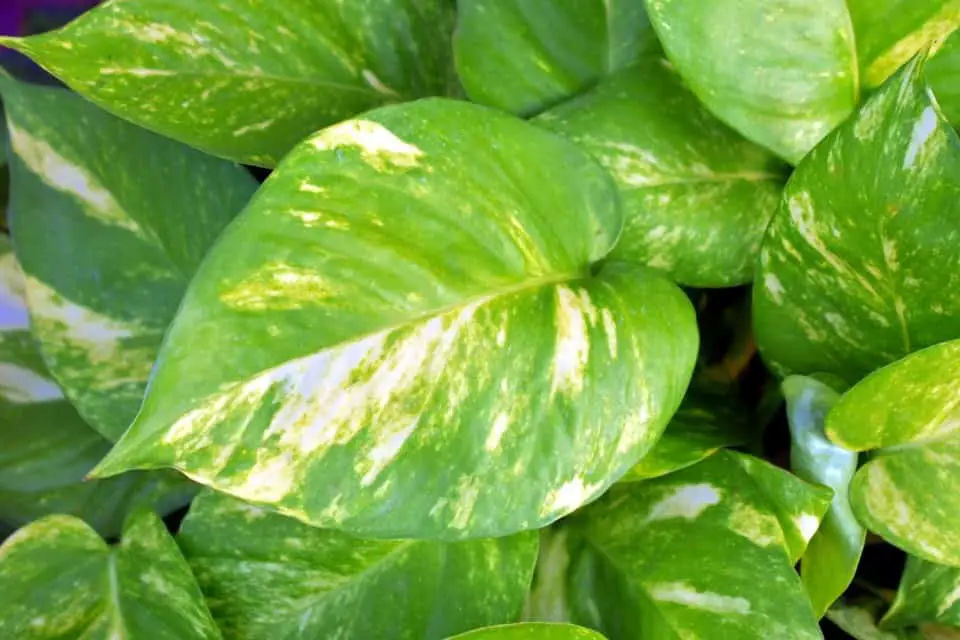Some links in the post are affiliate links and I get a commission from purchases made through some links found in the post.
Are you a fan of pothos varieties? Who can blame you? After all, these are some of the most elegant houseplants in the market.
They are not only low maintenance but are also easy to grow. It also helps that they light up their environments thanks to their striking aesthetics.
It’s easy to get confused when telling the pothos varieties apart. It’s especially so when it comes to the Pothos N Joy Vs Pearls and Jade.
From afar, they seem to be the same plant. But a closer look reveals that these plants, while from the larger pothos classification, are pretty different.
Let’s uncover what makes them similar and what sets them apart.
We will start by exploring the Pothos N Joy, a pothos cultivar with white and green variegation in its leaves.
It’s also known as N’Joy Pothos or Epipremnum pinnatum, and it currently ranks as one of the most aesthetically pleasing pothos varieties.
And that’s saying something, seeing as all pothos varieties are pretty beautiful. Here’s where it gets interesting. The N Joy variety is a result of breeding.
The reasoning behind this breeding program was to create a cultivar with bright variegation. And the scientists behind this program nailed it!
The N Joy wins when it comes to colorful green leaves with well-defined white variegation. So, you can quickly tell where the green starts and stops.
What about the Pearls and Jade? Like the N Joy, this pothos cultivar resulted from mutation-selection of the Marble Queen pothos.
As a result, it has much smaller leaves compared to the Marble Queen and other pothos. And the variegation is quite interesting.
This plant features white, and grey variegation instead of the usual green and white like you would see in the N Joy.
It helps that it comes in a compact size, enabling you to display it on tables, baskets, and any other spaces where its unique characteristics can shine.
Now that you have some background about these species, let’s get into their key similarities and differences.
You may also like: Pothos vs Philodendron
Pothos N Joy Vs Pearls and Jade – What Are the Similarities?
Can we start by stating the obvious? They are both pothos! So, if nothing else comes to mind, you can use that as a starter. Now, let’s get a bit deeper into their shared characteristics.
Growth Patterns
 Both the N Joy and the Pearls and Jade are pothos, and you can thus expect them to share some characteristics. One of these is their growing patterns.
Both the N Joy and the Pearls and Jade are pothos, and you can thus expect them to share some characteristics. One of these is their growing patterns.
Both are climbing plants that rely on external support to climb vertically. In the wild, they attach to trees and start moving to the light.
Under such conditions, they can reach several feet in height – But in indoor conditions, they often average heights of one to two feet.
After all, they don’t have much leeway in support, and most people prune the species to tame their growth.
Is there any key difference you can note in their climbing patterns? There is one, but it’s quite hard to make out – the internodes.
In the N Joy pothos, these average lengths of 2 inches. But in the Pearls and Jade, they measure up to 3 inches. It’s not much of a difference, but you could use it.
Flowering
If you have come across wild pothos, you know that mature species give rise to flowers. But that is not the case with the N Joy and Pearls and Jade.
Seeing as they are cultivars, they do not flower, which is a bit of a bummer. But they make up for this with their elegant, variegated leaves.
Stem Sheaths
Did you know that the N Joy and Pearls and Jade pothos varieties do not have sheaths on their stems? In other plants, sheaths surround the stems as a means of protection. But in these pothos, that’s not the case.
Soil Requirements
To grow any of these species, you must remember that they are pothos. And what do pothos need in their soil? Well, they need well-draining and loose soil.
That means that using sand or soil is not suitable. Instead, you should find a potting mix that balances between these extremes. How can you do this?
You have two options. The first is to get an aroid potting mix – it saves you the work and helps you hack the mix in a few moves.
But if you want to do it yourself, you can use the second option. Mix equal parts of perlite, potting soil, and compost. Then you will be good to go.
Watering
It should not be a surprise that these plants crave similar care requirements. After all, they come from the same mother plant – the Marble Queen. So, what works for the goose will work for the gander in this case.
How much water do these species need? While they are not too particular about the amount of water they get, they prefer growing in a moist potting mix.
So, that’s all you need to remember. Rather than watering every few days or once a week, only water the plants when the soil indicates that they need watering.
How? – By digging into the top inches of soil. If this soil section feels dry, you can water the plant. But if it’s moist, the plants can do without more water for a while longer.
But of course, if you are too lenient or too generous with the watering schedule, the plants can start showing signs of stress. These include:
It’s always better to underwater a plant than to overwater it. The latter creates conditions suitable for root rot, which can kill the plant. It can result from too much watering, a poor choice of potting mix, blocked drainage holes, a bad choice of pot, etc.
To avoid such issues, we recommend investing in a moisture gauge. That way, you can tell when the water levels are not optimum and amend them accordingly.
If you are enjoying this article, check out this article on a hawaiian pothos vs a golden pothos.
Light Requirements
Is it surprising that these plants have similar light requirements? Hardly. Both plants do well when exposed to bright and indirect light as they would get in the wild.
In such conditions, the N Joy becomes brighter, and it is much easier to tell the white sections from the green ones.
The same conditions hold for the Pearls and Jade thanks to the lack of chlorophyll on large leaf sections. Failure to get enough light results in pale-looking leaves.
So, just how much light do these plants need? Studies reveal that 6 to 8 hours of bright light should do.
When growing the plants indoors, that amounts to placing them towards the eastern, southern, or western rooms in the house. Outdoors, you should place them near shade so that they are not in direct contact with the sun.
What happens to these pothos varieties in full sun? It can be tempting to leave the plant in direct sun. After all, the more sun they get, the brighter the leaves will be, right?
Wrong- exposure to direct light leaves the foliage damaged, which results in paler leaves. If the plant starts showing signs of sun damage, move it at least 3 feet away from the window or use sheers to prevent too much light entry.
Are there any light requirements in the winter? During the cold months, the reduced exposure to light could affect the plant’s aesthetics. In such cases, you can use artificial light.
Temperature & Humidity Needs
 Again, this similarity comes down to the fact that these plants are both pothos. Let’s start with the temperature.
Again, this similarity comes down to the fact that these plants are both pothos. Let’s start with the temperature.
Pothos do well when placed in rooms with temperatures ranging between 65°F to 85°F. In most zones, maintaining such temperatures should be easy.
But in the colder months, that could be a challenge. Please note that when the temperatures fall below 50°F, the plant gets exposed to cold damage and stress.
Its growth can stunt, and, in some cases, the plant can even die. Thus, you should place the plant away from windows, cooling vents, and any other areas which could induce such stress.
Too much heat is not good for the plant either. So, when temperatures are above 85°F, you should look out for any signs of stress, including drooping and browning on the leaves.
To avoid this, you should keep the plant in a cool place away from heating vents.
How about humidity? Are pothos particular about how much moisture should be in the air? Well, yes! These plants thrive in rooms with a humidity range between 50% and 70%.
After all, they are tropical plants and ranges below and above these would not be ideal. Of course, such a range is not the norm in all homes.
Gauge your humidity levels and try to increase them (where necessary) using measures such as:
- Placing the pot on a tray filled with pebbles and rocks,
- Leaving empty basins of water near the plant,
- Installing a humidifier,
- Misting the plant,
- Ventilating the room, and
- Opening the doors to the kitchen and bathroom.
If you are unsure of the humidity in your home, use an air moisture meter to measure the current levels.
You may also like: Why do pothos leaves drip water
Fertilization
Are pothos heavy feeders? Do you need to invest in fertilizer, and if so, what kind should you get? In the wild, these plants depend on natural soil elements to thrive.
And given that their roots are free to wander, they often supplement their feeding as they grow. But in potted conditions, they cannot enjoy such freedom.
Thus, you must supplement their nutrients now and then. And while these plants are not heavy feeders, they appreciate being fed at least once every two months.
What kind of fertilizer should you use? We recommend using a liquid aroid fertilizer during the growing season.
Use it like you would water and allow the plant to soak up the nutrients until the next watering schedule. When colder months draw near, the plant goes into a state of dormancy.
Thus, any fertilizer used at this point goes to waste. Stop feeding the plant during the end of fall and all of winter.
Else, the fertilizer could build up to toxic levels in the soil, damaging the plant roots. If you suspect root damage, you must repot the plant in fresh soil or flush the current potting mix with fresh water.
Potting
Pothos roots can eventually become rootbound, leading to stunted growth and getting in the way of nutrient and water absorption.
So, how can you avoid this with the N Joy and Pearls and Jade? It’s easy—schedule repotting every one to two years. Of course, you must ascertain that the roots have almost filled the pot.
Else, you can always give the plant more time to fill up the space. When choosing a new pot, get one that is one to two inches larger than the current one.
Getting one that is too big only creates space for excess soil, which can retain more moisture than the plant needs.
If you are enjoying this article, check out this article on how to save your pothos from having brown stems.
Pothos N Joy Vs Pearls and Jade – What Are the Differences?
With all the similarities listed above, do these pothos have any differences? We earlier mentioned that telling these pothos apart is not always easy.
But if you know what sets them apart, you can hack this in a few steps. So, what should you look out for in these plants?
The Foliage
Are their leaves all that different? The answer is yes! Mature leaves in the N Joy Pothos feature pointed tips and measure 2 inches long and 1.5 inches wide.
Their leaves attach to the petioles at an angle, creating a heart shape. What about the Pearls and Jade? Well, here is where it gets a bit confusing.
Their leaves are also heart-shaped, thanks to the connection between the leaves and the petioles.
But their leaves are much bigger, averaging 3 inches in length and 1.5 inches in width. As a result, their heart shapes are more elongated than those of the N Joy.
But leaf shape is not the only significant difference between these leaves. Do you remember what we said about the N Joy resulting from breeding? Well, that defines its variegation.
In most pothos varieties, the green and white blend into each other, making it hard to tell where one starts and the other ends.
 But in the N Joy, the borders are clear. You can see where the dark green starts and where the white/ creamy white hue starts.
But in the N Joy, the borders are clear. You can see where the dark green starts and where the white/ creamy white hue starts.
Is that the case with the Pearls and Jade? Not at all. While this species also features white and green hues, the borders are not as clear as those in the N Joy.
Instead, you can find green spots on the white hues. Moreover, the white parts can also be grey in some cases.
And most importantly, this cultivar owes to the mutation of the Marble Queen species. Thus, it is much brighter than the N Joy species.
That means, to tell these two species apart, you must consider:
- The elongation of the heart shape,
- If the borders between the white and green hues are clear, and
- The intensity of the green hue (is it bright or dark?)
And you will then have an easier time telling the two species apart.
Final Thoughts: Pothos n Joy vs Pearls and Jade
The N Joy and Pearls vs Jade Pothos are pretty similar. In fact, their difference mainly lies in their foliage. That aside, everything else seems to be the same.
Thus, your choice should come down to the type of aesthetic you want to see in your home. Happy Gardening!
Before you go, here are some more related articles I encourage you to read below to help solve more of your gardening issues:


